Celine Grey gave this presentation at the Revenue Acceleration Festival in November 2022. Catch the replay of that event, and more, in the SEC member dashboard.
In this article, I’ll be discussing data democratization - but what do we mean by that? We mean the action of making data accessible to everybody.
Why’s that so important? Because it's a great way to flip sales accountability, which is one of the main issues that I encounter in team, after team, after team.
Who am I to talk about this? My name is Celine Grey, and I’m Director of Sales Enablement at Normative.io, and I have 25 combined years of sales experience as a sales rep, as a sales leader, and in sales enablement.
I’ve built a story and examples for you in this article. In the examples, there’s a lot of generalizations simply to keep the length of this article down - we know each organization has their own specificities.
The optimistic and pessimistic forecasters
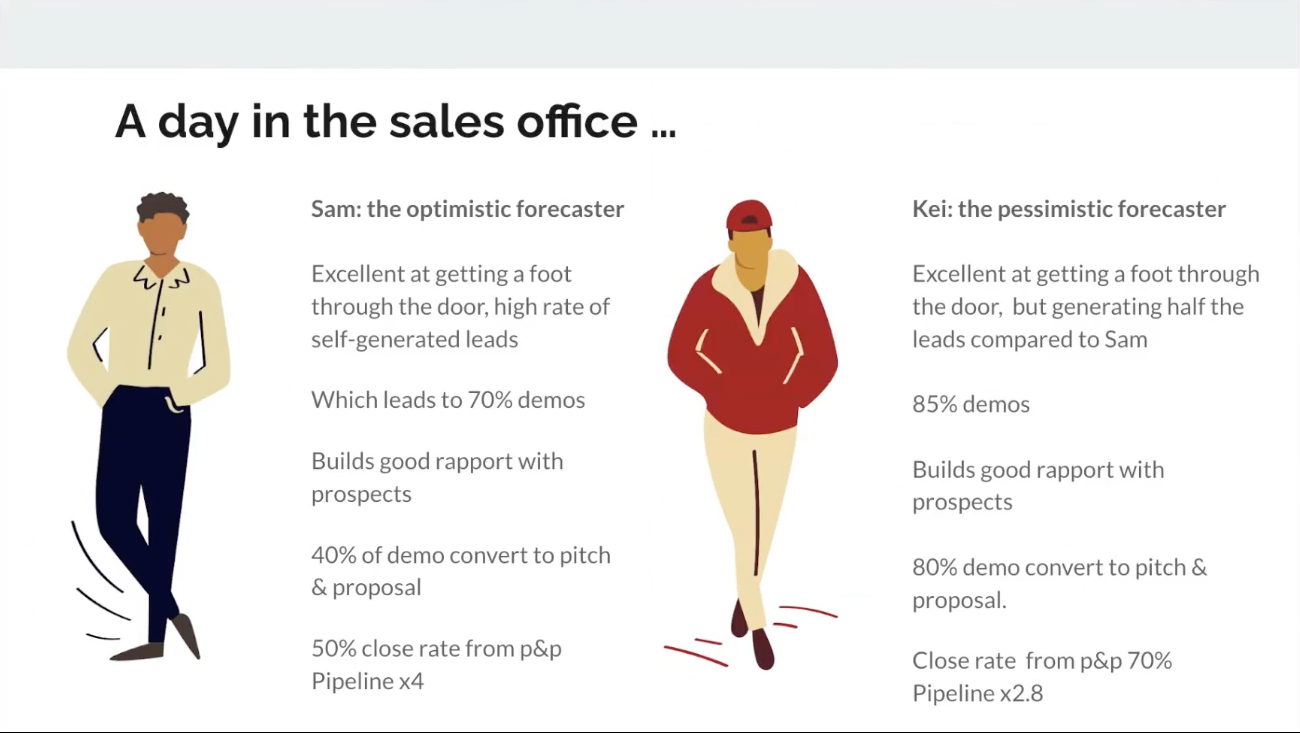
In the sales office, let me introduce you to Sam.
Sam is an optimistic forecaster, is excellent at getting his foot through the door, has a high rate of self-generated leads, and is booking a lot of demos.
Sam builds good rapport with prospects, but tends to get ghosted after pitching and proposal, and his pipeline is 4x.
And let’s introduce Kei.
Kei is a pessimistic forecaster. They’re excellent at getting their foot through the door but are generating half the leads that Sam is.
Their conversion rate is 85% going into demo. And they're also really, really good at building rapport with prospects.
Kei converts 80% of demos into pitch and proposal, with a close rate from pitch and proposal of 70%, and their pipeline is 2.8x.
These are two very different people.
The well-intended sales manager
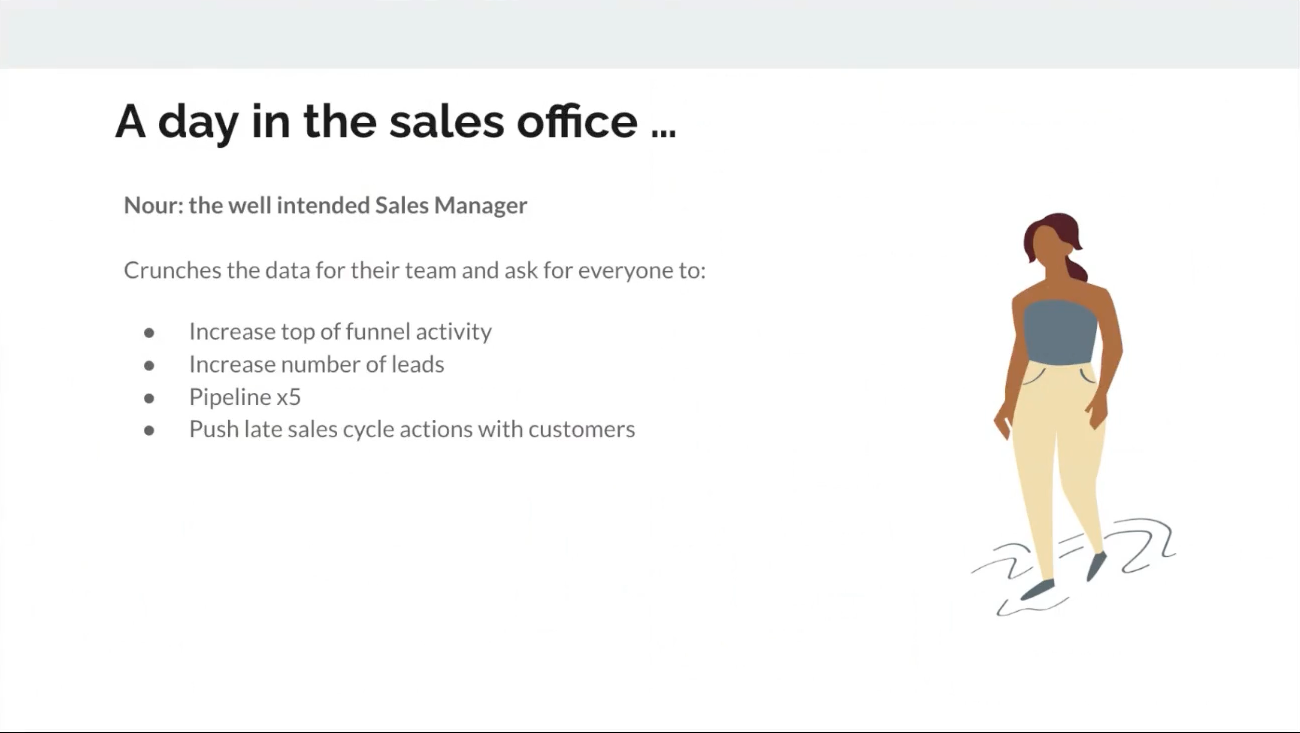
And this is Nour, and she’s Sam and Kei’s leader.
Nour knows that they're different, and she’ll need to crunch individual data to find a way to individually coach everyone.
Depending on Nour’s team’s size, this is going to become more and more complex. And what we see in the field ourselves is that leaders who don't have the time to dig into individual data for everybody and can’t do the whole process they knew at an individual level in a larger team.
What happens is that suddenly, we get a blanket approach to data.
So Nour crunches the data for the team, and she asks for:
- Everybody to increase the top funnel of activity by 20%.
- Increase the number of leads
- Everybody’s pipeline becomes 5x
- And also to push late sales cycle actions with customers because it seems that we're not converting as well as we should be.
Now, what happens to Sam and Kei?
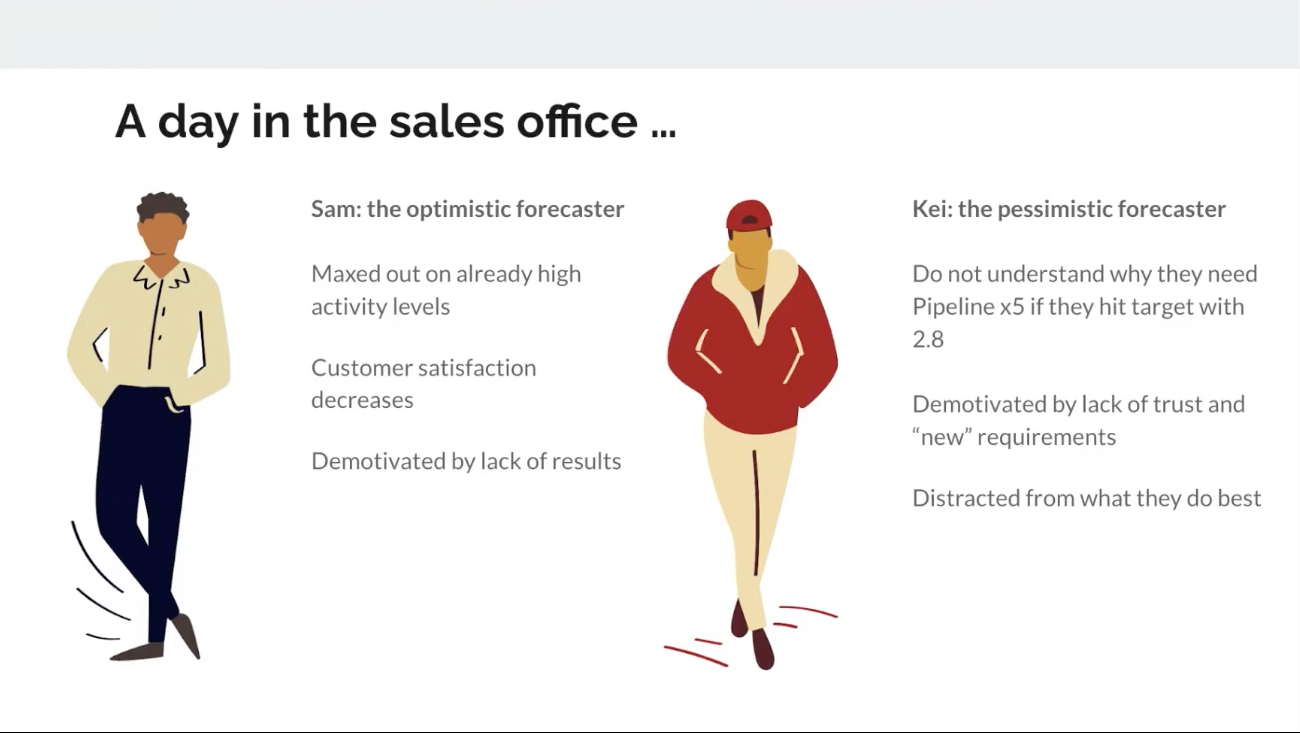
Well, Sam is maxed out on an already really high activity level. The customer satisfaction decreases with Sam, maybe because he's too pushy, but also because he doesn't have as much time in order to be able to actually attend to the rapport he was creating before.
And eventually, he'll find himself doing a lot more of the same thing that he was doing before, and starting to get demotivated by the lack of results.
What about Kei?
Kei, the pessimistic forecaster, doesn't understand why they need pipeline 5x if they hit their target with the number at 2.8x.
That new requirement is now distracting them from what they do best, and they're getting quite demotivated by the lack of trust and the new requirement.
Accountability to drive results
So how do you drive accountability?
The team has good intentions; they’re committed to following the leader and actually doing what's needed.
The missing link between commitment and good intention to achieving results is accountability.
And to flip the equation in a lot of organizations, the accountability for that data lies with the leader. But we need to empower everybody in the sales organization, SDRs, AEs, and AMs, to understand their own data - understanding it really well and how it relates to the specific activities that they're doing.
They need to think about how they can optimize quick wins - the actions they can take this quarter that are easy to reach, that’ll get them to hit quota, for example.
It’s also about activating marginal gains, which we're going to cover a little bit later in the article.
Instead of just doing one big action, doing a sum of small things that together are going to mitigate the risk of one initiative not working.
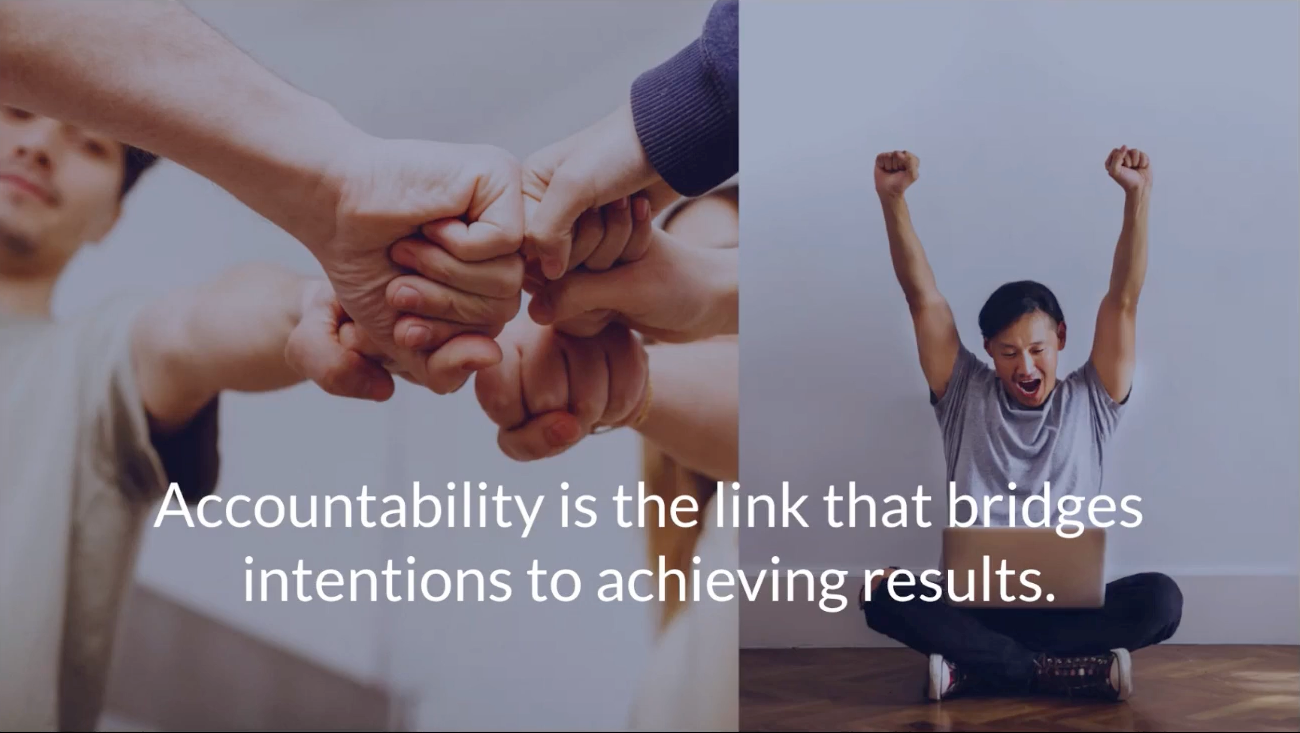
What happens now in this scenario is the leader is going to drive accountability through trust and leading by example.
Sales enablement is going to drive accountability through enabling each rep with the power of understanding data, how it relates to specific activities in the market and to what they do, and how they can optimize their performance.
All of this is easier with a platform, and you can find these platforms on the market, but it's also something you can do easily from your CRM.
Creating a data playbook
The first step is for you to create a data playbook, the same way we have a territory playbook, product playbook, solution playbook, or a sales playbook.
The data playbook will help ensure that accountability is driven through transparency and education with your rep.
Onboarding
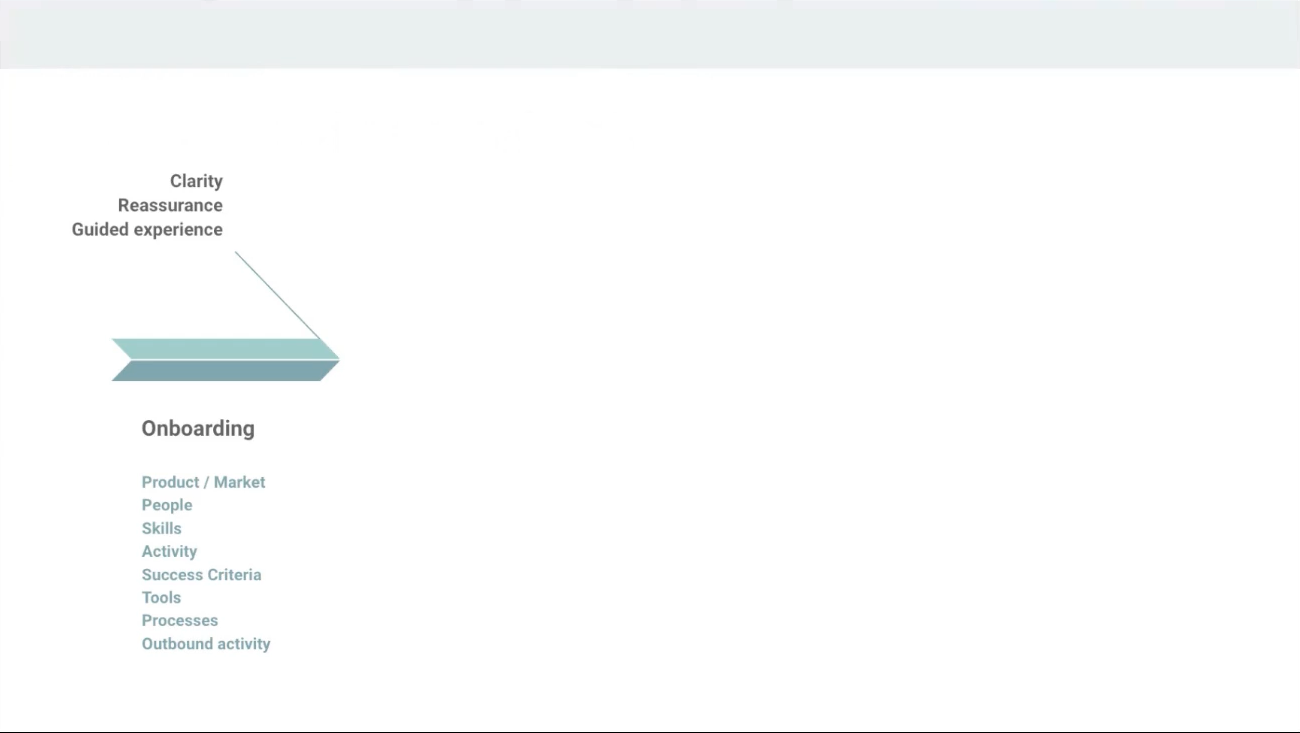
So how do you start? What you start with is the learner in mind - so you can just start with your employee's journey, and with the onboarding.
During the onboarding, it doesn't really matter what level of contentment or discontent they had before they joined your company. The fact of the matter is they were in a very comfortable position where they knew the people, they knew the process, the product, and then moved over to your company.
That sense of security is gone. There's excitement, of course, because they are excited by the new opportunity.
But at some stage, we're going to start seeing some insecurity start to kick in. So during onboarding, it’s very important for the mindset to actually be about setting clarity, providing reassurance - it should be a guided experience, right?
There's some examples of the things that you could cover in onboarding on the slide above.
Ramp-up
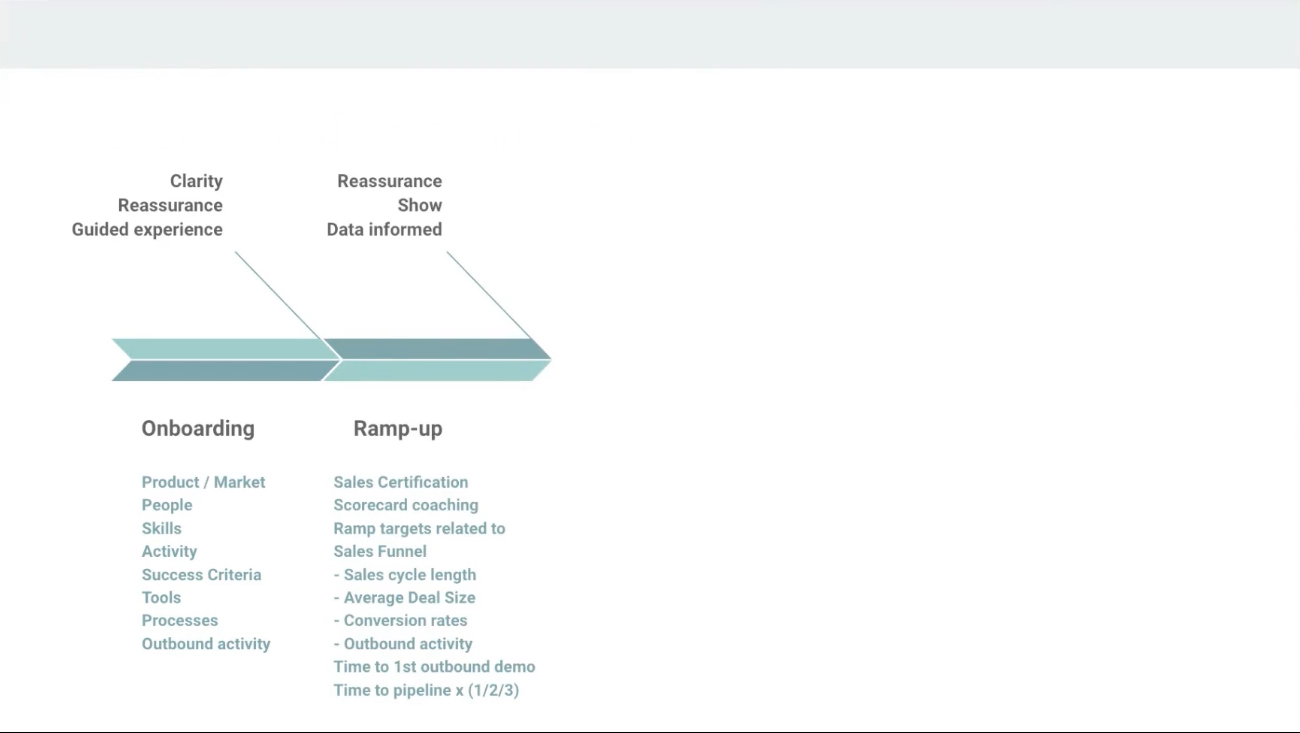
The next phase is the ramp-up phase after onboarding, with a ramp-up target.
We’ll assume that they would have done a self-certification, and in that self-certification, you should have a scorecard with some coaching tips on what they should do to be successful and what's missing for them to be successful, so that they have actions they can take.
Then, we can educate these salespeople on the sales funnel. I have an example of a sales funnel that I'm going to share later in the article along with how your team can use it.
We’re also going to start measuring ramp-up time, time to first outbound demo, time to first self-generated lead, etc. as well as time to pipeline.
Because even though Kei is not creating a lot of pipeline at 2.8x, we know they are very diligent in eliminating some of their opportunities.
But does it mean they’re actually eliminating things that we could potentially win? You can start digging into some of these behaviors.
Full ramp
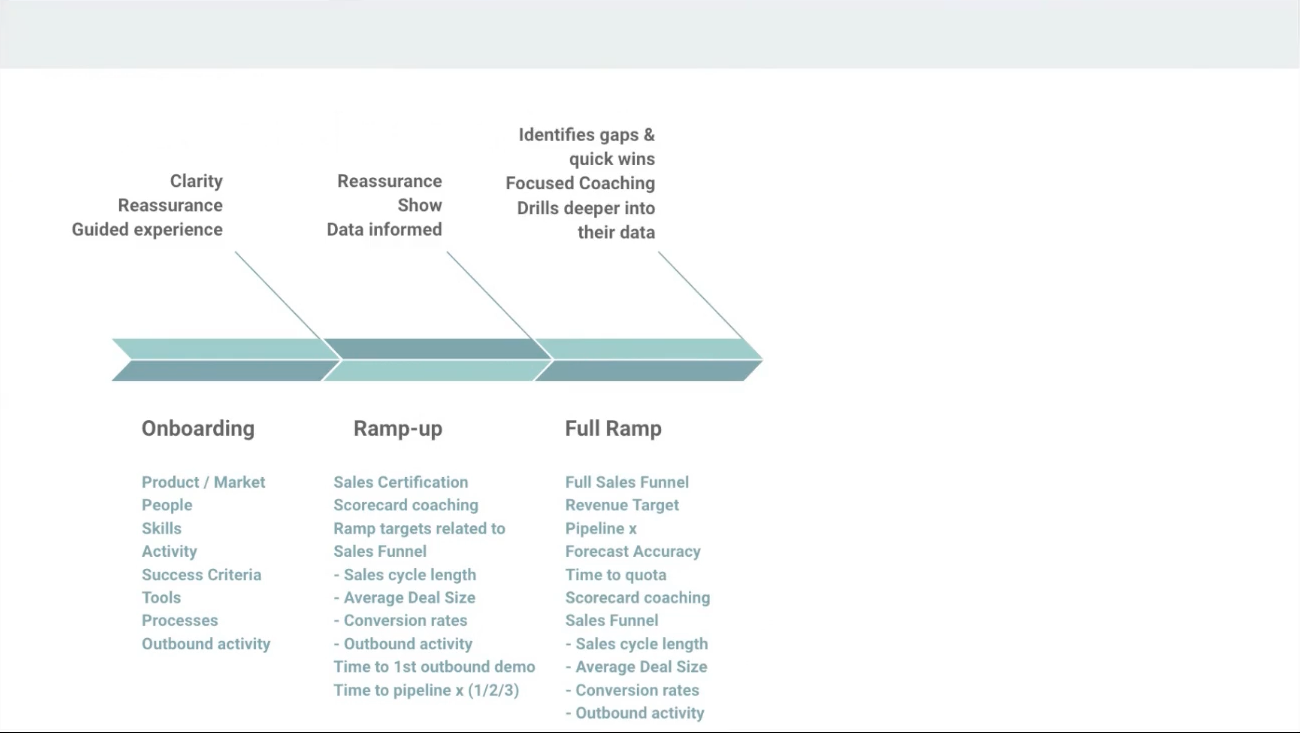
In the full ramp-up stage, your rep identifies gaps and quick wins.
They receive focused coaching, they’re able to drill into the deep end and you can look at a full set of data for them.
Develop
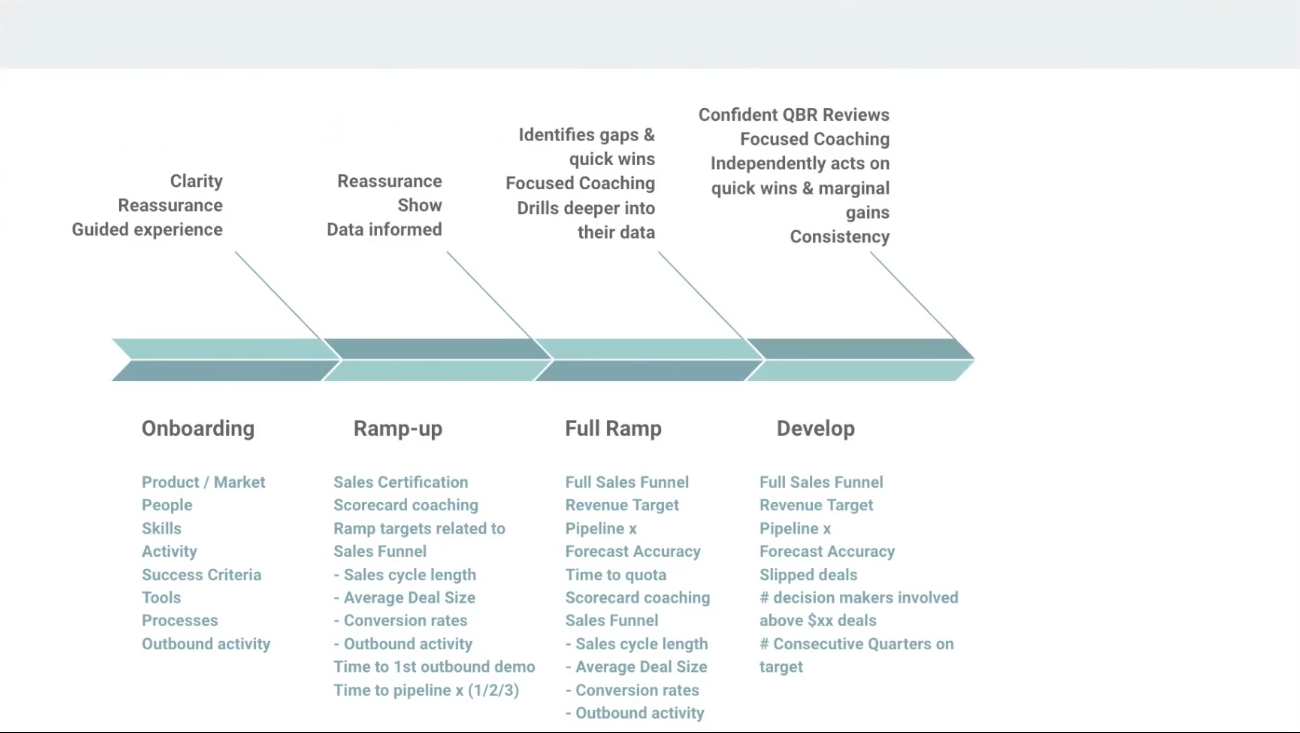
Then, your sales rep is developing and becoming more and more confident and competent in terms of data - they’ll be able to lead QBRs independently and confidently based on their data, and be able to reflect on what happened and what they need to do in the next quarter.
They can independently act on quick wins and marginal gains, and drive consistency in forecasting and hitting quotas.
Progress
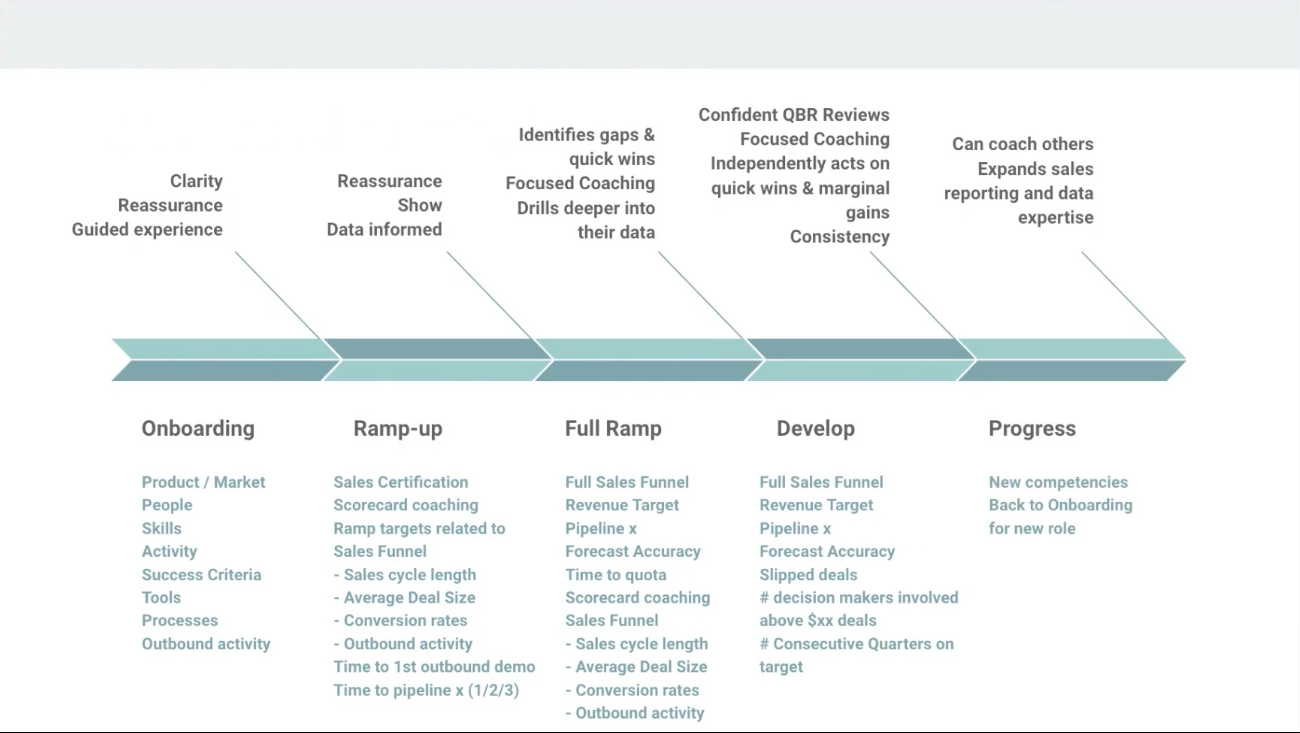
Finally, progress - which is often when there's a transition to a new role that can coach - however, they can expand sales reporting and data expertise.
Marginal gains in the sales funnel
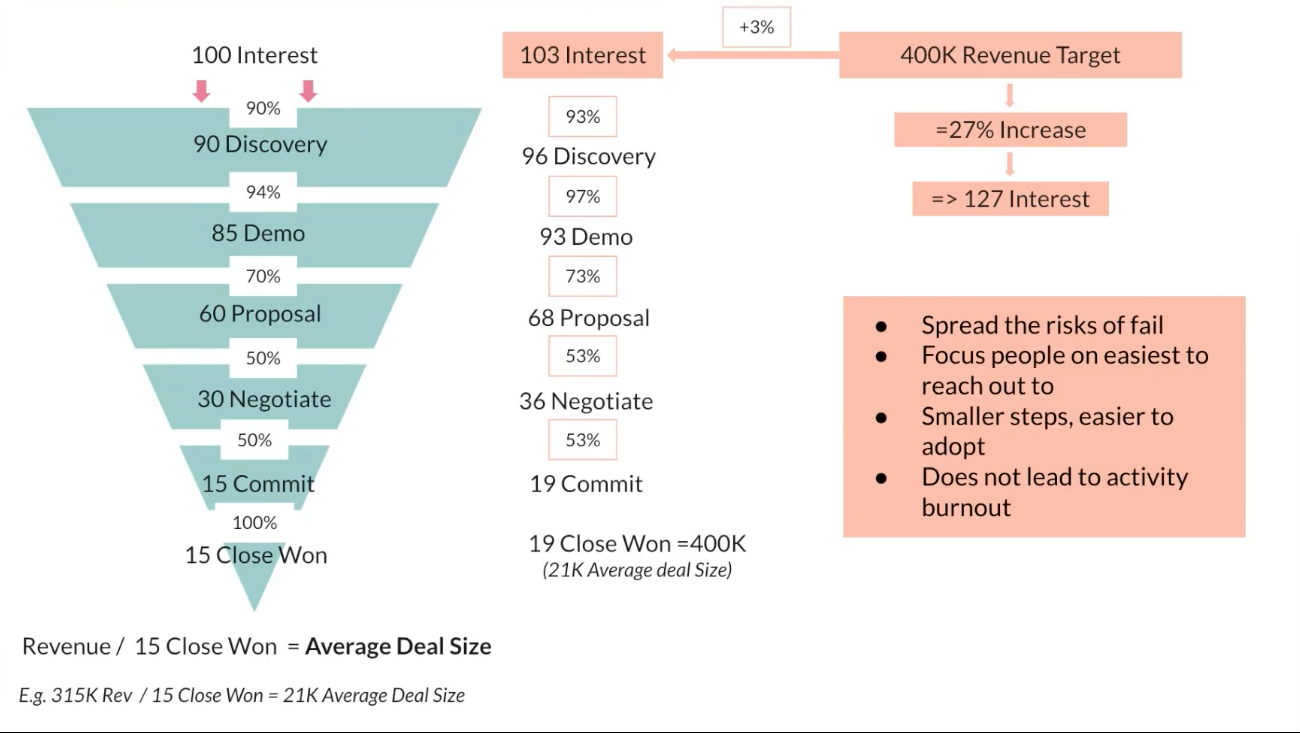
I want to give an example of what we enable reps on early in their onboarding. The earlier they understand this, the more enabled they are to take action.
Above is a typical funnel, right? So, for the sake of numbers, let's say we have 100 leads at interest, and that 90% of those convert to discovery, 94% of those convert to demo, 72% into proposal, 50% of those to negotiate, and 50% close.
We’ll imagine that we’re really good at committing, so it's the same as close won.
The one other figure that I'm going to calculate is what my average deal size is, right? So, let's say here, I've got 315k of revenue divided by 15 close won, that's a 21k average deal size.
But my revenue target is 400k.
So, there are a couple of options I can look at in order to reach the 27% increase (400k versus the 350k in revenue that I'm currently doing).
I could go “I need to fill in my funnel more, and have 127 interests at the same conversion rates, I'm going to get the 19 close won that I need in order to hit my target.
There are a couple of issues with this approach. The first one is risk mitigation. If that does not work, there's no fallback.
The other thing is, what is the capacity of your team? If they are already maxed out in terms of lead generation, adding 27% more work might or might not actually work really well.
So, what we want is to train the reps to understand efficiency in the funnel.
I'm going to ask them to look at 3% more at each step, which is going to be far easier to do than a straight 27% increase.
That means instead of 100 leads at interest, I want 103. So what do they need to do in order to get three more leads?
And I'm going to ask them to convert 93% of them - and increase by 3% at every single stage. By just adding 3% at every stage, which is just a little bit more, I'm going to have 19 committed deals, representing 400k in revenue.
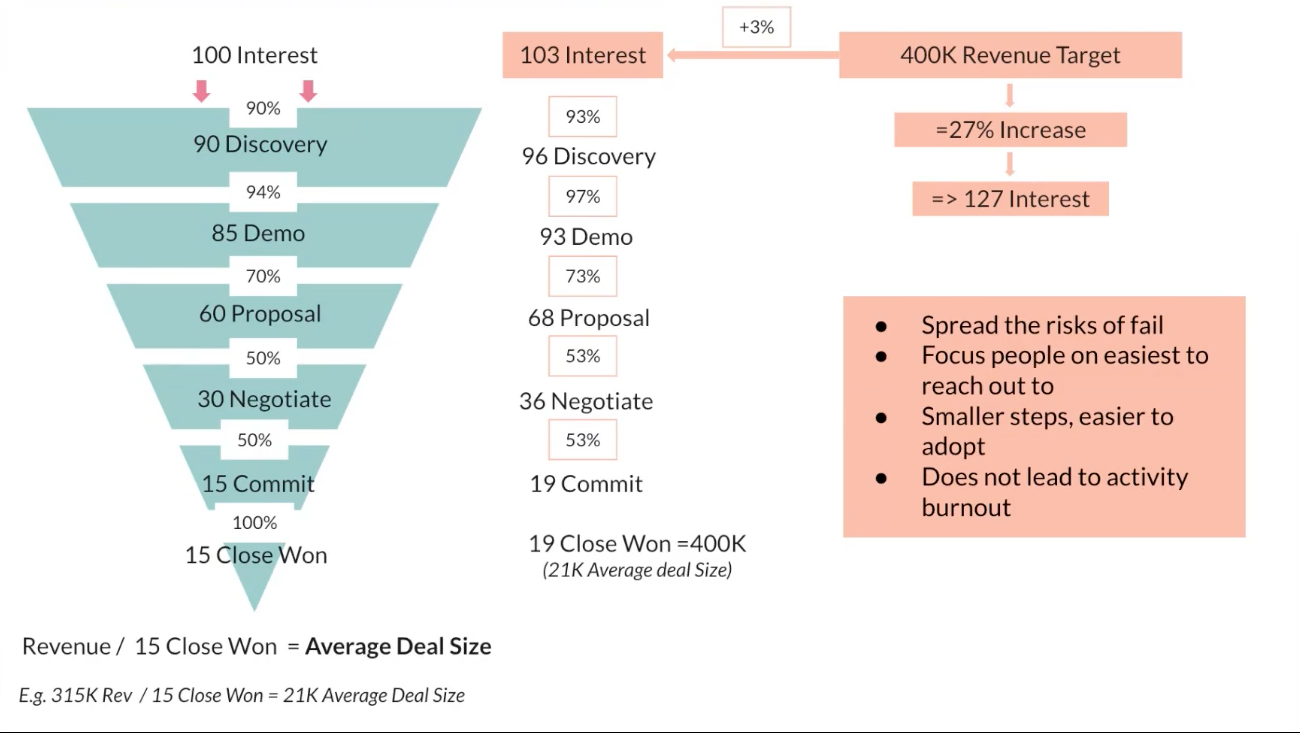
Why marginal gains work
This also means that if one strategy fails, I have a fallback, and it's not going to completely fail.
The other thing you can do is look at the funnel and the conversion rates.
For the rep, it's great because they can look at this and go, "Hang on a minute, I do 60 proposals, but only 30 go to negotiation at 50%. What if I was converting 60%? What is the cause of me not converting my proposal to negotiation?"
And so we can start looking at specific actions they can take, which can help increase output without putting an immense amount of additional work at the top.
So it's really about working smarter rather than harder.
Looking at data this way is going to help the rep spread the risk of failing, focus on exactly what they need to do, the metrics that matter, and things that are easiest to reach out to.
You may have in the beginning a funnel with conversion rates that are not great in certain places, so play to their strengths, improve this, and then move forward.
It's also a smaller step, much easier to adopt, and it does not lead to activity burnout either.
So this is why it's crucial to enable the sales team member with the data so that they can be successful.
They can look at it and be in control of the decisions they make and the paths they take in order to hit targets.
The idea is really that they have all these levers and all these indicators, and depending on market conditions, the state of the pipeline, the type of deals they have, the time left in the quarter to hit quota - I want them to think, "What is the lever that I can action in the timeframe that I have in the current situation that I'm in, in order to hit or exceed target?"
This is why it's so important for the sales team to have that data independence that really helps them be successful, and so that they are in control of the decisions they make.
How this affects the organization
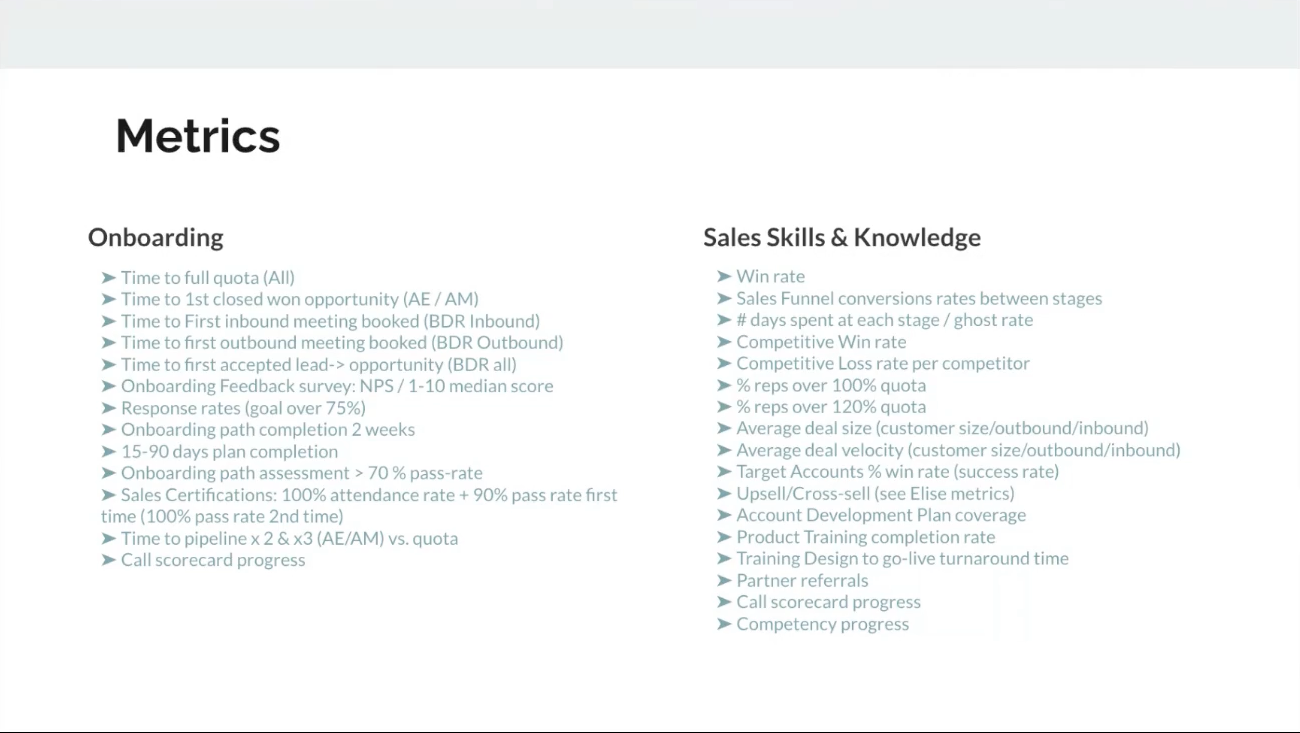
The leader, instead of having to crunch the same data for different people and have to make sense of it, can then focus that time into coaching, educating, guiding, and doing all the work in terms of nurturing the environment that the salesperson is in, in order for them to be successful and focus on their whole team to be successful.
Now, in terms of enablement, we have targets as well. So for the sake of data, I've actually added this list of metrics to this article - something I get asked quite a lot.
Data is like a Rubik's cube; we look at it differently - we look at the same data but slightly differently.
So how do we measure the effectiveness of the initiatives we're running with a rep, based on the team funnel and the individual funnel?
Above are just some examples of some of the things that we're measuring for onboarding, for everything from sales skills and knowledge to video.
In summary
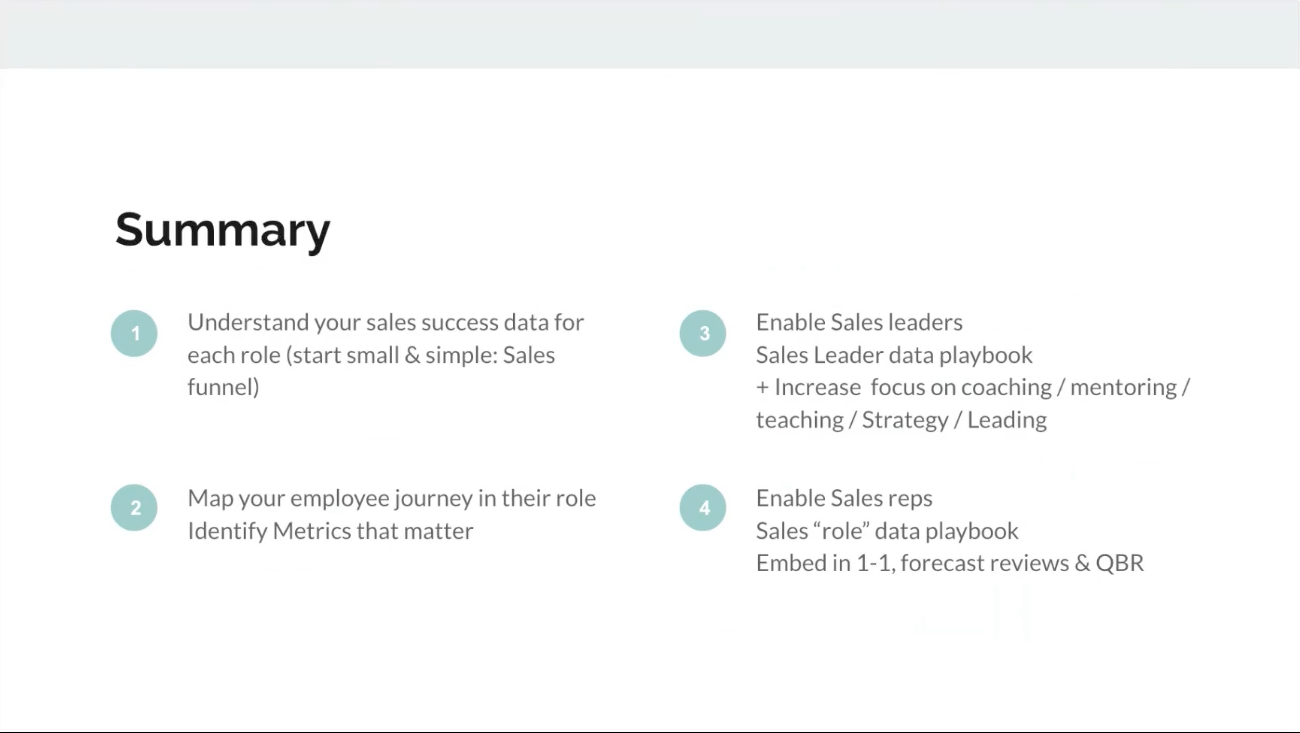
So here’s a quick summary on this:
- Understand success data for each role. Start small and simple, with a sales funnel, if you don't have anything else.
- Map your employee journey in their role, and identify the metrics that matter at every stage of that journey. Communicate with them and coach them on them, the same way you would train them on product and themselves.
- Enable sales leaders. Build a sales leader data playbook, and increase the focus on coaching and mentoring. Coaching yields amazing results with sales teams, in addition to the engagement and contribution it creates, which leaves more time for your leader to also mentor, teach, do some strategy and leading, etc.
- Enable sales reps. Create a data playbook, an SDR data playbook. You can keep it very, very simple - the simpler, the better. And then it can be embedded into one-to-one and forecast reviews, and in QBRs. Everybody will work from the same metrics, in different ways, based on what their strengths are, reaching their goals a lot quicker.
So in summary, data democratization is about making data accessible to everybody, and empowering everyone in the sales organization to understand their own data, how it relates to specific activities in the market and in what they do, and how they can optimize this.
This will drive accountability through transparency and education. When sales reps are enabled with data, they can be successful, they can be in control of the decisions they make and the paths they take in order to hit targets.
And this means that leaders can focus on coaching, educating, guiding, and nurturing the environment that salespeople are in, in order for them to be successful, and on guiding the whole team to be successful.
Thank you for reading!



